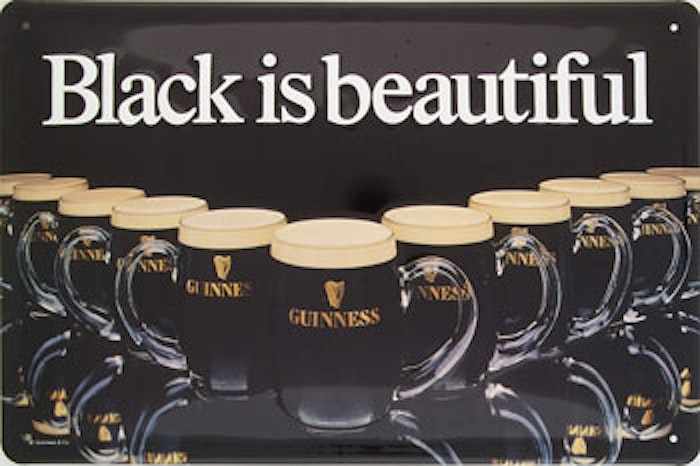It was mentioned yesterday that one topic you would have liked to learn more about is the period in the middle of the twentieth century that joins the Black and Green Atlantics. That time of radicalism and revolution.
It is a period that interests me as well and I look forward to discussing it with a new group of students in the Fall. The course, Bloody Conflict in America and Ireland: 1968-69, will explore how the decade that began with young idealism and revolutionary possibilities, ended with raised fists and violent terror.
One way that that period is rich with connections are the visual images that were created.
Thinking of this moment, I immediately remember the Guinness poster created in the 1970s that commercializes the “Black is Beautiful” slogan. That slogan became popular in the 1960s as a way of promoting black beauty and confidence that black women should reject European beauty standards, including wearing their hair naturally. Sixty years later, politics still surround the way in which black women wear their hair. 
Though I have to do more research into the history of the poster, a 1978 NY Times editorial on the Americanization of modern Ireland found the poster crude. In, “The Blueing of Ireland,” the staff writer wrote:
On a commanding hillside overlooking Waterford stands a new hostelry imported from Miami, its lobby dominated by a huge bar and its environs stripped of any distracting public verandas. It took a week and the counsel of American, not Irish, guides to find “real” Irish bread and other delicacies. Most hotels limit themselves to American‐style toast and commercial marmalade. The potato alone has survived the cosmopolitan pretensions of the new Irish kitchen. And, as one American observed, the Irish have become an instant‐coffee nation. They are surrounded, too, by billboards, the worst of them shouting “Black is Beautiful” for the Guinness dark beer people. The one consolation of Ireland is the snail’s pace of everything — including change. There is still time to save the Republic if enough Americans will let it be known that they cross the Atlantic to find a taste of Ireland not home.
Personally, I like the Guinness “Black is Beautiful” poster. It makes me smile. Black is beautiful and the poster adds an additional layer to the multiple connections between black America and Ireland. The fascination (and at times, fetishization) of blackness in Ireland does not seem violent. For better or worse, even those offensive gestures are attempts at understanding Irish displacement; expressing solidarity with another participant in the struggle.
On 24 May, the Working Class Movement Library (WCML) is holding an online discussion regarding their Spring 2020 exhibition. This move to an online forum is another reminder about how in loss we have also gained during the pandemic. If it were business as usual, I would not have the opportunity to participate in the exhibition. If you take a look at the posters from the Civil Rights Era in Ireland, you will find a Black Panthers, Free Huey poster. And when I wrote WCML to find out more information on the exhibition, the exhibit’s curator was reminded of this moment remembered by Eamonn McCann in War and an Irish Town.
One of the loudest cheers I ever heard in the Bogside came in response to the cry: “The whole black nation has to be put together as a black army, and we’re gonna walk on this nation, we’re gonna walk on this racist power structure and we’re gonna say to the whole damn government-STICK ‘EM UP MOTHERFUCKER, this is a hold up, we’ve come for what’s ours…
The declaration was the last item in the ten-point programme of the Black Panther Party, enunciated in rich, booming R&B tones on the soundtrack of a film projected against the gable which was later to become Free Derry Wall, in the small hours of a riotous night in 1969.
The cheer had as much to do with the daring of the language as with the sentiment of the slogan. But it also signalled the extent to which civil rights campaigners at that time felt an association with the Panthers, then under murderous assault by the feds and local police forces across the US.
The international dimension has virtually been written out of history. The North is scarcely mentioned in accounts of sixties revolutionism, even by some who came among us to be pictured at barricades, clenched fists on militant show.
To insist now on the relevance of internationalism is to venture onto ground which has been little disturbed by the stride of standard-issue chroniclers who assume that Northern Ireland…
There’s a deep well of these connections and it was a pleasure sharing some of them with you. I look forward to seeing you all again in the Fall.
More information on the posters can be found here. Please get in touch if you are interested in joining the 24 May talk.
